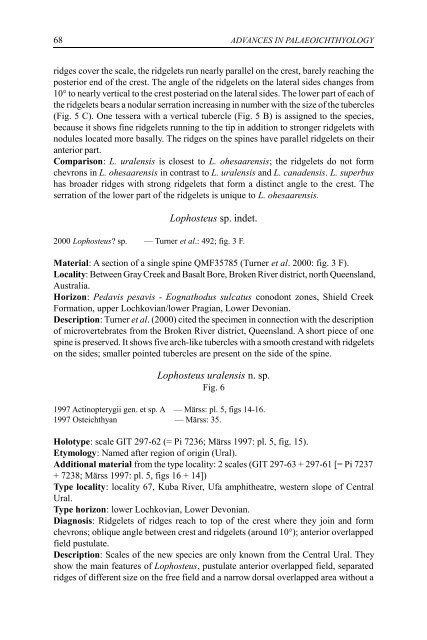Zemes un vides zinātnes Earth and Environment Sciences - Latvijas ...
Zemes un vides zinātnes Earth and Environment Sciences - Latvijas ...
Zemes un vides zinātnes Earth and Environment Sciences - Latvijas ...
You also want an ePaper? Increase the reach of your titles
YUMPU automatically turns print PDFs into web optimized ePapers that Google loves.
68 ADVANCES IN PALAEOICHTHYOLOGY<br />
ridges cover the scale, the ridgelets r<strong>un</strong> nearly parallel on the crest, barely reaching the<br />
posterior end of the crest. The angle of the ridgelets on the lateral sides changes from<br />
10° to nearly vertical to the crest posteriad on the lateral sides. The lower part of each of<br />
the ridgelets bears a nodular serration increasing in number with the size of the tubercles<br />
(Fig. 5 C). One tessera with a vertical tubercle (Fig. 5 B) is assigned to the species,<br />
because it shows fine ridgelets r<strong>un</strong>ning to the tip in addition to stronger ridgelets with<br />
nodules located more basally. The ridges on the spines have parallel ridgelets on their<br />
anterior part.<br />
Comparison: L. uralensis is closest to L. ohesaarensis; the ridgelets do not form<br />
chevrons in L. ohesaarensis in contrast to L. uralensis <strong>and</strong> L. canadensis. L. superbus<br />
has broader ridges with strong ridgelets that form a distinct angle to the crest. The<br />
serration of the lower part of the ridgelets is <strong>un</strong>ique to L. ohesaarensis.<br />
Lophosteus sp. indet.<br />
2000 Lophosteus? sp. — Turner et al.: 492; fig. 3 F.<br />
Material: A section of a single spine QMF35785 (Turner et al. 2000: fig. 3 F).<br />
Locality: Between Gray Creek <strong>and</strong> Basalt Bore, Broken River district, north Queensl<strong>and</strong>,<br />
Australia.<br />
Horizon: Pedavis pesavis - Eognathodus sulcatus conodont zones, Shield Creek<br />
Formation, upper Lochkovian/lower Pragian, Lower Devonian.<br />
Description: Turner et al. (2000) cited the specimen in connection with the description<br />
of microvertebrates from the Broken River district, Queensl<strong>and</strong>. A short piece of one<br />
spine is preserved. It shows five arch-like tubercles with a smooth crest <strong>and</strong> with ridgelets<br />
on the sides; smaller pointed tubercles are present on the side of the spine.<br />
Lophosteus uralensis n. sp.<br />
Fig. 6<br />
1997 Actinopterygii gen. et sp. A — Märss: pl. 5, figs 14-16.<br />
1997 Osteichthyan — Märss: 35.<br />
Holotype: scale GIT 297-62 (= Pi 7236; Märss 1997: pl. 5, fig. 15).<br />
Etymology: Named after region of origin (Ural).<br />
Additional material from the type locality: 2 scales (GIT 297-63 + 297-61 [= Pi 7237<br />
+ 7238; Märss 1997: pl. 5, figs 16 + 14])<br />
Type locality: locality 67, Kuba River, Ufa amphitheatre, western slope of Central<br />
Ural.<br />
Type horizon: lower Lochkovian, Lower Devonian.<br />
Diagnosis: Ridgelets of ridges reach to top of the crest where they join <strong>and</strong> form<br />
chevrons; oblique angle between crest <strong>and</strong> ridgelets (aro<strong>un</strong>d 10°); anterior overlapped<br />
field pustulate.<br />
Description: Scales of the new species are only known from the Central Ural. They<br />
show the main features of Lophosteus, pustulate anterior overlapped field, separated<br />
ridges of different size on the free field <strong>and</strong> a narrow dorsal overlapped area without a
















